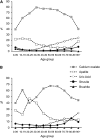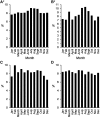Stone composition as a function of age and sex
- PMID: 25278549
- PMCID: PMC4255407
- DOI: 10.2215/CJN.05660614
Stone composition as a function of age and sex
Abstract
Background and objectives: Kidney stones are heterogeneous but often grouped together. The potential effects of patient demographics and calendar month (season) on stone composition are not widely appreciated.
Design, setting, participants, & measurements: The first stone submitted by patients for analysis to the Mayo Clinic Metals Laboratory during 2010 was studied (n=43,545). Stones were classified in the following order: any struvite, any cystine, any uric acid, any brushite, majority (≥50%) calcium oxalate, or majority (≥50%) hydroxyapatite.
Results: Calcium oxalate (67%) was the most common followed by hydroxyapatite (16%), uric acid (8%), struvite (3%), brushite (0.9%), and cystine (0.35%). Men accounted for more stone submissions (58%) than women. However, women submitted more stones than men between the ages of 10-19 (63%) and 20-29 (62%) years. Women submitted the majority of hydroxyapatite (65%) and struvite (65%) stones, whereas men submitted the majority of calcium oxalate (64%) and uric acid (72%) stones (P<0.001). Although calcium oxalate stones were the most common type of stone overall, hydroxyapatite stones were the second most common before age 55 years, whereas uric acid stones were the second most common after age 55 years. More calcium oxalate and uric acid stones were submitted in the summer months (July and August; P<0.001), whereas the season did not influence other stone types.
Conclusions: It is well known that calcium oxalate stones are the most common stone type. However, age and sex have a marked influence on the type of stone formed. The higher number of stones submitted by women compared with men between the ages of 10 and 29 years old and the change in composition among the elderly favoring uric acid have not been widely appreciated. These data also suggest increases in stone risk during the summer, although this is restricted to calcium oxalate and uric acid stones.
Keywords: calcium oxalate; calcium phosphate; infrared spectroscopy; struvite; uric acid.
Copyright © 2014 by the American Society of Nephrology.
Figures




References
-
- Mandel NS, Mandel GS: Urinary tract stone disease in the United States veteran population. II. Geographical analysis of variations in composition. J Urol 142: 1516–1521, 1989 - PubMed
-
- Herring LC: Observations on the analysis of ten thousand urinary calculi. J Urol 88: 545–562, 1962 - PubMed
-
- Prien EL: Studies in urolithiasis. III. Physicochemical principles in stone formation and prevention. J Urol 73: 627–652, 1955 - PubMed
-
- García Alvarez JL, Torrejón Martínez MJ, Arroyo Fernández M: Development of a method for the quantitative analysis of urinary stones, formed by a mixture of two components, using infrared spectroscopy. Clin Biochem 45: 582–587, 2012 - PubMed
-
- Schubert G: Stone analysis. Urol Res 34: 146–150, 2006 - PubMed
Publication types
MeSH terms
Substances
Grants and funding
LinkOut - more resources
Full Text Sources
Other Literature Sources

